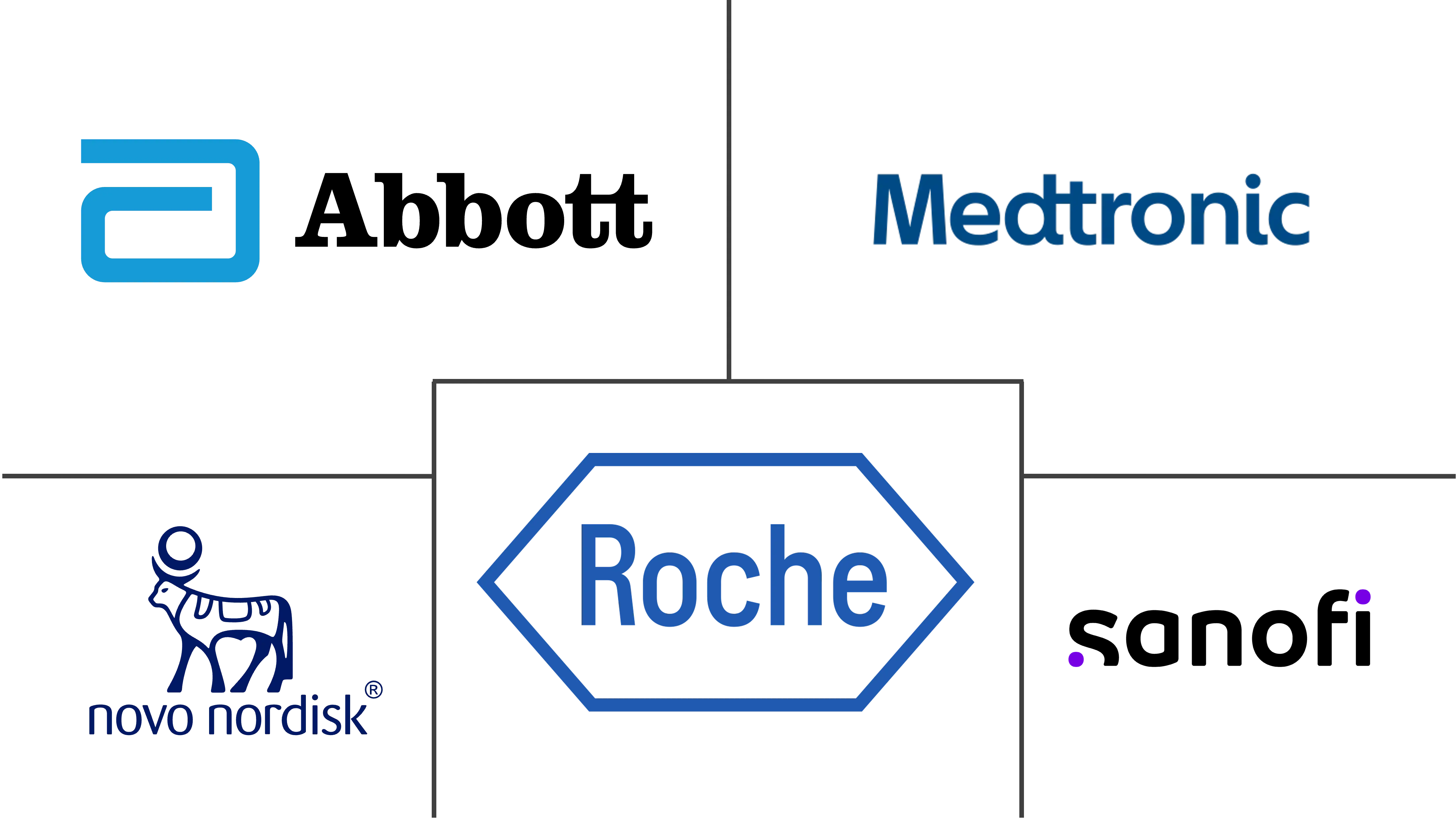Canada Diabetes Care Drugs And Devices Market Size and Share
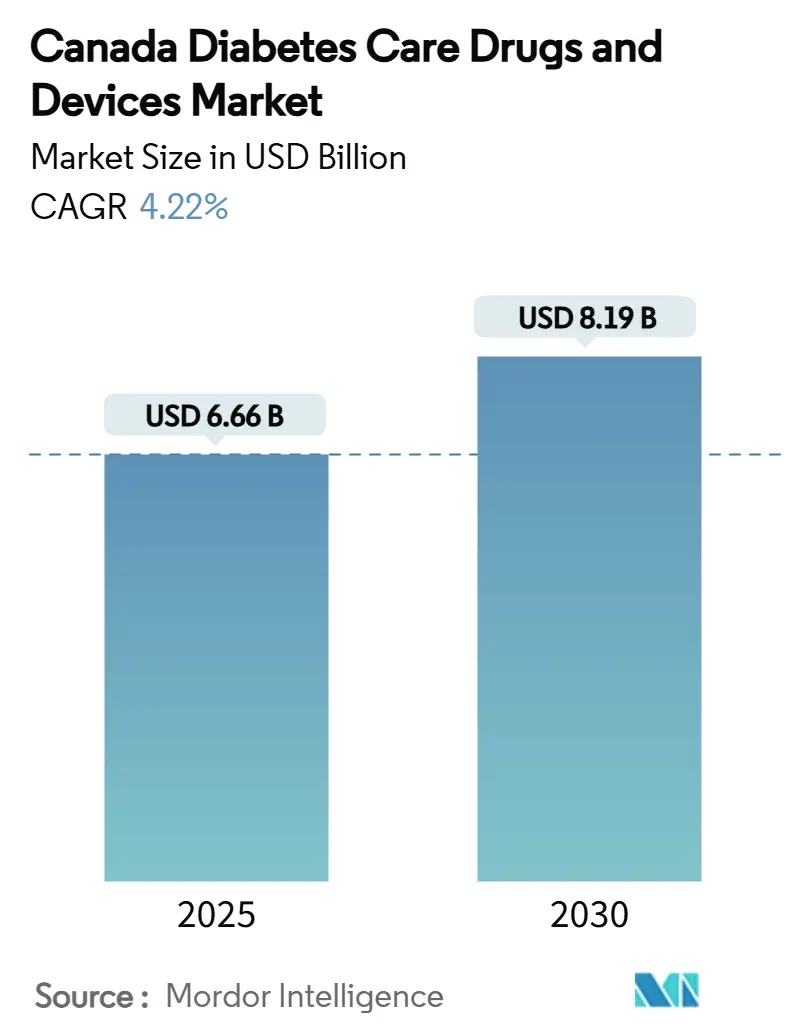
Canada Diabetes Care Drugs And Devices Market Analysis by Mordor Intelligence
The Canada Diabetes Care Drugs And Devices Market size is estimated at USD 6.66 billion in 2025, and is expected to reach USD 8.19 billion by 2030, at a CAGR of 4.22% during the forecast period (2025-2030).
Universal pharmacare, population ageing and rapid device innovation act together to keep demand on a stable upward track. Federal coverage for diabetes medicines, provincial funding for continuous glucose monitoring (CGM) and insulin pumps, and the arrival of once-weekly insulins are broadening patient access while lifting revenue visibility for suppliers. Strategic alliances that join sensors, pumps and decision-support software are reshaping competitive boundaries, and private insurers have started testing premium models tied to glycemic outcomes. Nevertheless, disparate provincial tendering practices, high out-of-pocket insulin costs and privacy concerns in cloud-based monitoring continue to temper the adoption pace.
Key Report Takeaways
- By product type, drugs accounted for 65.67% of the Canada diabetes care drugs and devices market share in 2024, whereas devices are projected to grow at a 4.98% CAGR to 2030.
- By diabetes type, Type 2 dominated with 90.12% revenue share in 2024; Type 1 is expected to advance at a 5.03% CAGR through 2030.
- By age group, adults held 61.32% share of the Canada diabetes care drugs and devices market size in 2024, while the geriatric cohort is poised for 5.08% CAGR expansion.
- By distribution channel, offline retail and hospital pharmacies captured 74.45% share in 2024; online platforms exhibit the highest growth at 5.12% CAGR, supported by subscription-based CGM offerings.
Canada Diabetes Care Drugs And Devices Market Trends and Insights
Drivers Impact Analysis
| Driver | (~) % Impact on CAGR Forecast | Geographic Relevance | Impact Timeline |
|---|---|---|---|
| Increasing prevalence of Type-2 diabetes | +1.2% | National, with higher concentration in Ontario, Quebec, Alberta | Long term (≥ 4 years) |
| Government reimbursement expansion for CGM & pumps | +0.8% | Provincial variations, with BC and Nova Scotia leading | Medium term (2-4 years) |
| Uptake of once-weekly and oral GLP-1s | +0.7% | National, with urban centers showing faster adoption | Medium term (2-4 years) |
| Digital-therapeutic integrations with HbA1c-linked insurance premiums | +0.4% | National, with private insurance markets in Ontario, Alberta | Short term (≤ 2 years) |
| Venture investment surge in Canadian diabetes tech start-ups | +0.3% | Concentrated in Toronto, Vancouver, Montreal tech hubs | Short term (≤ 2 years) |
| AI-driven closed-loop for smart pens and phone ecosystems | +0.5% | National, with early adoption in metropolitan areas | Medium term (2-4 years) |
| Source: Mordor Intelligence | |||
Increasing Prevalence of Type 2 Diabetes
Diagnosed cases are set to jump from 4 million in 2024 to 5.2 million by 2030, equal to nearly 13% of Canadian adults. Indigenous communities face a 17.2% prevalence rate, and Black Canadians experience double the mortality risk compared with white Canadians. More than 7,700 diabetes-related lower-limb amputations occur each year, 85% of which are preventable with timely intervention [1]Canadian Institute for Health Information, “Lower-Limb Amputations Among Adults with Diabetes,” cihi.ca. Provincial disparities widen market opportunities—for example, Saskatchewan already counts 29% of residents living with diabetes or pre-diabetes, while Alberta’s 28% prevalence equates to 587,710 diagnosed patients and USD 556 million in direct medical costs. Over the next decade, the economic burden is forecast to exceed USD 15.3 billion, underscoring the value of preventive devices and integrated care models that demonstrate measurable outcome improvements.
Government Reimbursement Expansion for CGM & Pumps
Nova Scotia broadened public funding for insulin pumps and CGM in February 2024, and Saskatchewan now fully covers Dexcom G6 and G7 sensors for eligible residents, eliminating out-of-pocket costs [2]JDRF Canada, “Insulin Pump and CGM Coverage Expands in Nova Scotia,” jdrf.ca . FreeStyle Libre 2 is publicly reimbursed in most provinces; Ontario’s drug program funds 33 sensors a year for insulin-dependent patients, while Quebec reimburses children under 18 and adults on intensive insulin therapy. In British Columbia, a four-year USD 670 million pharmacare deal will deliver universal diabetes coverage from March 2026.
Uptake of Once-Weekly and Oral GLP-1s
Health Canada cleared Awiqli, the world’s first once-weekly insulin icodec, in March 2024. The therapy lists at USD 1,350 per year and reduces injection frequency from 365 to 52 doses. Ozempic revenues climbed 26% to DKK 120.3 billion in 2024, reflecting strong GLP-1 momentum, whereas Lilly’s Mounjaro delivered USD 3.09 billion in Q2 2024 sales [3]Eli Lilly and Company, “Q2 2024 Earnings Release,” lilly.com . University of British Columbia scientists are advancing an oral insulin drop that exploits sublingual absorption, potentially altering administration patterns for 11.7 million Canadians living with diabetes or pre-diabetes.
Digital Therapeutics Linked to Insurance Premiums
Medavie Blue Cross attributes 11% of claims spending to diabetes drugs, with the ave rage claimant cost reaching USD 1,534 in 2024. Its 360 Total Care program marries drug coverage with virtual coaching, showcasing how digital platforms translate adherence gains into measurable payor savings. Machine-learning algorithms such as XGBoost have begun powering predictive models for glycemic excursions, letting insurers adjust premiums against real-time HbA1c metrics.
Restraints Impact Analysis
| Restraint | (~) % Impact on CAGR Forecast | Geographic Relevance | Impact Timeline |
|---|---|---|---|
| High out-of-pocket cost for long-acting analog insulins | -0.6% | National, with higher impact in provinces with limited coverage | Long term (≥ 4 years) |
| Fragmented provincial tendering delays device adoption | -0.4% | Provincial variations, particularly affecting smaller provinces | Medium term (2-4 years) |
| Data-privacy concerns slowing cloud-based monitoring | -0.3% | National, with higher concern in Quebec due to language laws | Short term (≤ 2 years) |
| Limited French-language support in mobile apps affecting Québec uptake | -0.2% | Quebec-specific, affecting 23% of Canadian population | Medium term (2-4 years) |
| Source: Mordor Intelligence | |||
High Out-of-Pocket Cost for Long-Acting Analog Insulins
Canadian spending on antidiabetic drugs doubled to USD 2.7 billion between 2012 and 2021, with list prices remaining above peer-country levels, adding USD 703 million in excess costs. Blood-glucose test strips average USD 0.79 each, yet reimbursement thresholds differ widely by province, and Quebec residents pay nearly USD 500 per month for Ozempic when prescribed for weight management rather than diabetes. Downstream complications inflate system expenses; diabetes-related amputations alone exceed USD 750 million annually.
Fragmented Provincial Tendering Delays Device Adoption
Each province runs its own tender and formulary process, producing variable timelines for CGM and hybrid closed-loop coverage. CADTH projects that fully funding closed-loop systems would raise public spending by USD 823 million over three years, a hurdle that slows coordinated uptake. Different prior-authorization rules and age cut-offs force suppliers to navigate 15 distinct public plans, stretching administrative lead times and eroding the scale benefits of nationwide launches.
Segment Analysis
By Product Type: Devices Drive Innovation Despite Drug Dominance
Drugs captured 65.67% of the Canada diabetes care drugs and devices market share in 2024, reflecting entrenched use of insulin analogues and GLP-1 receptor agonists. Novo Nordisk’s diabetes care division posted DKK 290.4 billion in 2024 sales, a 25% jump that underscores the segment’s resilience. Still, the devices category is slated for the fastest advance at a 4.98% CAGR to 2030. Monitoring devices form the largest slice; CGM adoption continues to displace finger-stick meters as public and private plans expand reimbursement coverage. Management devices such as hybrid closed-loop pumps are scaling quickly, helped by Abbott–Medtronic integration that links FreeStyle Libre sensors to automated delivery algorithms, broadening the addressable user base and opening a USD 100 million incremental sales channel for Abbott.
Market participants are refining go-to-market tactics. Abbott emphasizes affordability to penetrate the Type 2 population, whereas Dexcom keeps focus on the intensive insulin cohort where alarm accuracy and real-time data sharing command premium pricing. Tandem Diabetes Care’s t:slim X2 pump integrated with Dexcom G7 won notice among Canadian endocrinologists because software upgrades are delivered online, cutting replacement cycles and supporting iterative innovation. Collectively, these trends keep the devices segment central to value creation even though drugs still dominate total revenue.
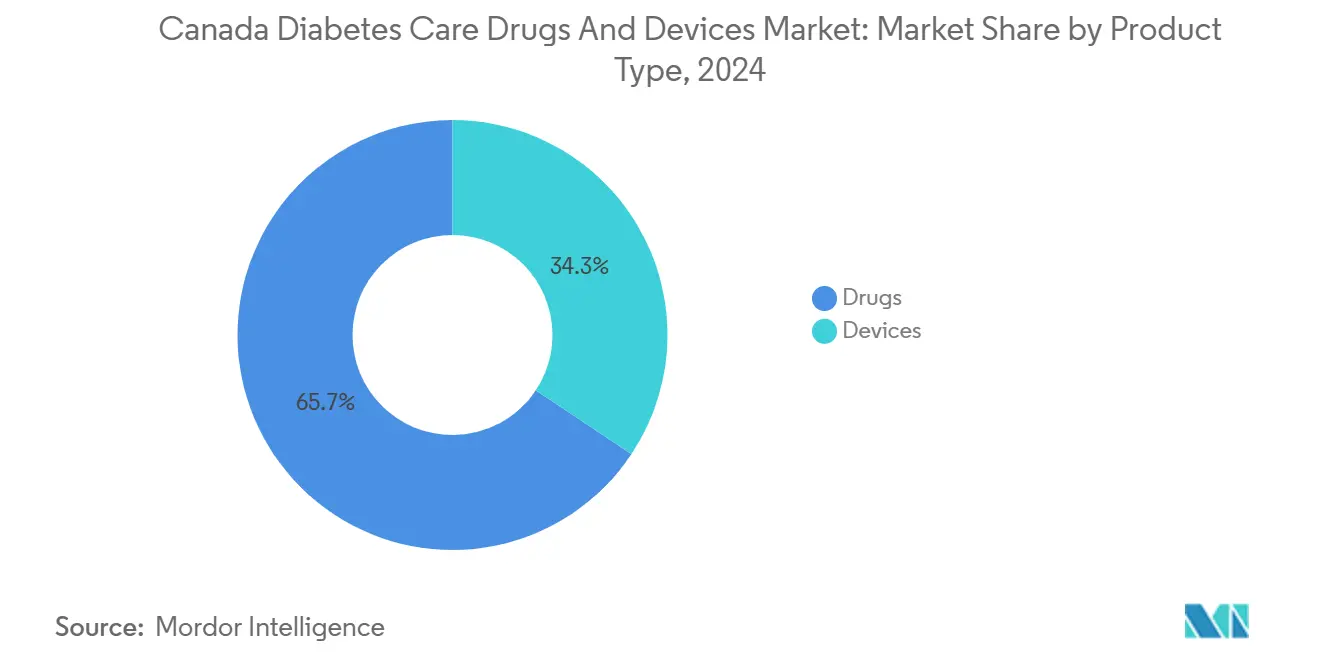
Note: Segment shares of all individual segments available upon report purchase
By Diabetes Type: Type 1 Innovation Drives Disproportionate Growth
The Canada diabetes care drugs and devices market size for Type 2 patients accounted for USD 6.0 billion in 2025, equal to 90.12% of total market revenue. Expanded GLP-1 indications for cardiovascular and renal protection reinforce this concentration, yet Type 1 is positioned for a faster 5.03% CAGR, powered by technology-intensive therapy. Health Canada approved Insulet’s Omnipod 5 automated insulin delivery system in April 2024, giving Type 1 users a tubeless option that integrates with Dexcom sensors and smartphone control. Type 1 households show higher device penetration because sustained exogenous insulin demands favour adoption of closed-loop systems that reduce hypo- and hyper-glycemic excursions.
Within Type 2, weekly insulins and oral GLP-1s are attracting patients who previously relied solely on tablets. Cardiovascular-outcome data for semaglutide and dapagliflozin have made combination therapy more common in primary care. Gestational diabetes care remains a small but technically dynamic subsegment; researchers reviewing 15 mobile apps found only three offered culturally relevant features, highlighting product gaps for diverse Canadian families. Vendors able to overlay French and Indigenous-language support may capture outsized loyalty in Quebec and remote communities respectively.
By Age Group: Geriatric Segment Accelerates Amid Demographic Shift
Adults aged 18-64 controlled 61.32% of market revenue in 2024, yet the geriatric cohort is on course for 5.08% CAGR growth. Population ageing, multi-morbidity and longer life expectancy keep clinical complexity high among seniors, driving demand for simplified dosing and automated monitoring solutions. Telehealth adoption among older adults accelerated after COVID-19, with established physician relationships cited as a chief facilitator even as sensory and dexterity limitations complicate device training.
For working-age adults managing Type 1 diabetes, remote peer-support initiatives such as the TRIFECTA program improved quality-of-life metrics in early trials, showing how digital forums reinforce adherence outside clinical settings. Pediatric volumes remain comparatively small but carry high long-term lifetime value, since early positioning of pump-CGM bundles can lock in brand preference for decades. However, coverage gaps in some provinces still push families toward charitable funding channels, an issue advocacy groups lobby to rectify through broader pharmacare equity.
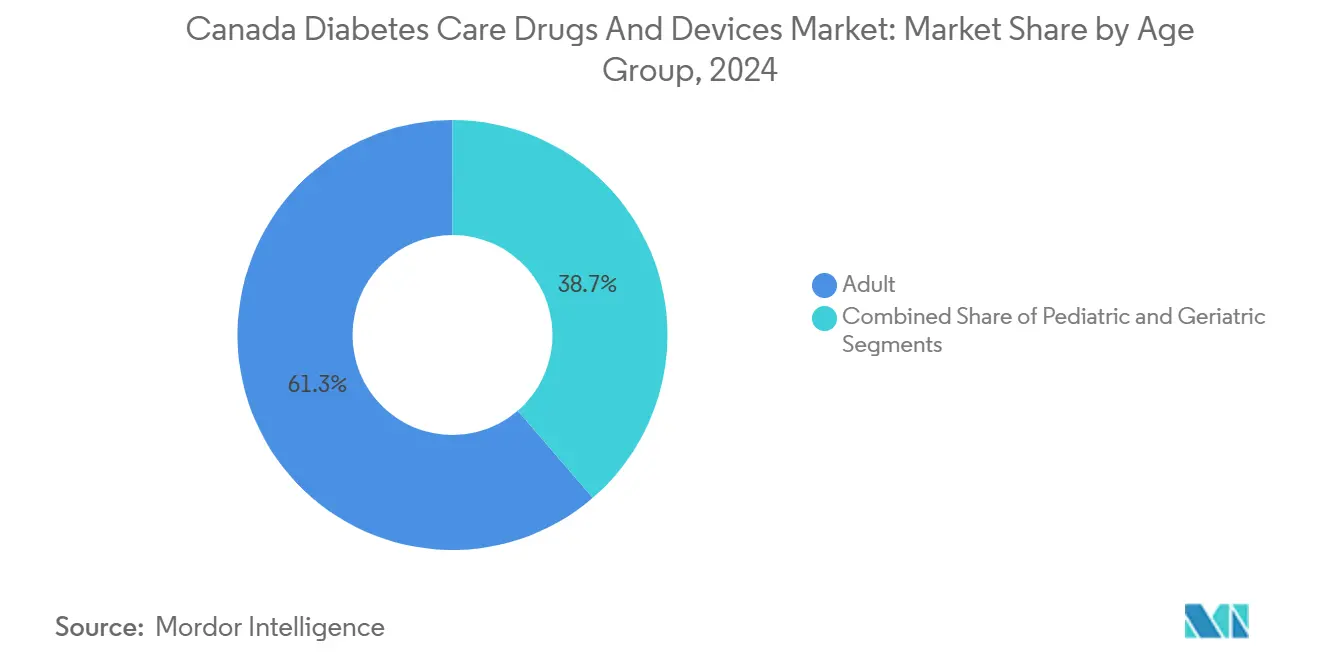
Note: Segment shares of all individual segments available upon report purchase
By Distribution Channel: Digital Transformation Accelerates Online Growth
Offline channels—chain pharmacies, hospital dispensaries and durable medical equipment retailers—retained 74.45% of sales in 2024. Direct-billing agreements with public plans shield patients from immediate out-of-pocket costs, and in-store diabetes educators provide set-up and training services. Online sales, while smaller, are expanding at 5.12% CAGR as consumer comfort with e-commerce and tele-consults improves. Dexcom’s Canadian subscription bundles ship sensors and transmitters to households on a scheduled cadence and offer financing plans that reduce upfront burden.
AI-driven recommendation engines underpin many digital pharmacies, matching refill reminders with glycemic-trend analytics to limit stock-outs and improve medication persistence. Still, rural broadband limitations, particularly in northern territories, constrain online penetration, requiring hybrid models that marry web ordering with local pick-up points or nurse-supported drop-offs.
Geography Analysis
Regional variation characterizes the Canada diabetes care drugs and devices market, as each province balances demographic realities with fiscal capacity. Ontario is the single largest market, serving nearly 1.5 million people with diabetes through programs that co-fund insulin pumps and CGM sensors under the Assistive Devices Program. Quebec follows, where French-language mandates and unique reimbursement algorithms force vendors to localize software interfaces and patient education; The Régie de l’assurance maladie du Québec administers more than 40 health schemes that include tailored diabetes coverage.
British Columbia’s USD 670 million pharmacare accord with Ottawa will take effect in March 2026, offering a template for universal diabetes coverage that other provinces are evaluating. Alberta faces an estimated USD 556 million annual cost burden tied to diabetes, prompting expanded CGM eligibility under its insulin therapy benefit.
Saskatchewan offers full public funding for Dexcom G6 and G7 sensors to residents aged 18-25 and those over 65, a configuration that eliminates many affordability concerns. Atlantic provinces, led by Nova Scotia, are rapidly enhancing pump and CGM programs to address ageing populations scattered across rural geographies. In the North, tele-endocrinology pilots and culturally adapted education materials aim to narrow outcome gaps among Indigenous communities where prevalence exceeds national averages.
Competitive Landscape
The Canada diabetes care drugs and devices industry features a fragmented supply side. Top pharmaceutical players—Novo Nordisk, Eli Lilly and Sanofi—control most insulin and GLP-1 revenue. On the device front, Abbott and Dexcom form an effective duopoly in CGM, yet they pursue different population segments to avoid direct overlap. Abbott’s FreeStyle Libre focuses on cost-sensitive Type 2 users, while Dexcom targets accuracy-driven Type 1 patients.
Strategic alliances now blur boundaries: Abbott’s partnership with Medtronic allows FreeStyle Libre sensors to feed Medtronic’s closed-loop algorithms, a move projected to generate at least USD 100 million in incremental annual revenue for Abbott. Insulet’s Omnipod 5 and Tandem’s t:slim X2 secure competitive positions by enabling software updates over the air, shortening product cycles and keeping users within branded ecosystems. Start-ups out of Toronto, Vancouver and Montreal attracted fresh venture capital in 2024 to develop culturally specific decision-support apps, though privacy and bilingual design add scaling complexity.
Entry hurdles remain material. Suppliers must pass Health Canada’s device class reviews and adjust marketing to meet Quebec language law, while disparate tender calendars across 13 jurisdictions dilute launch efficiency. Companies able to align multi-channel reimbursement dossiers, bilingual user support and robust cloud-security assurances are more likely to command durable share.
Canada Diabetes Care Drugs And Devices Industry Leaders
-
Roche
-
Sanofi
-
Novo Nordisk
-
Abbott Laboratories
-
Medtronic
- *Disclaimer: Major Players sorted in no particular order
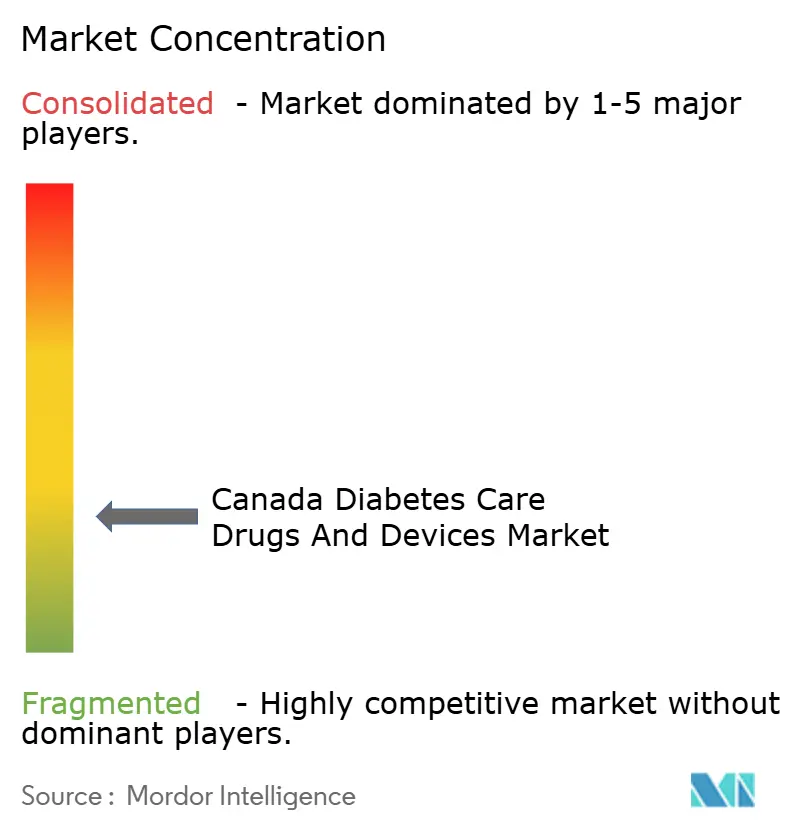
Recent Industry Developments
- March 2025: Government of Canada and British Columbia signed a USD 670 million, four-year pharmacare agreement offering universal diabetes coverage starting March 2026.
- October 2024: Parliament passed the Pharmacare Act, guaranteeing nationwide access to diabetes medicines and establishing a device fund.
- August 2024: Abbott partnered with Medtronic to integrate FreeStyle Libre CGM with Medtronic pumps, targeting 11 million intensive insulin users worldwide.
- March 2024: Health Canada authorised Awiqli, the first once-weekly insulin icodec from Novo Nordisk Canada Inc.
Research Methodology Framework and Report Scope
Market Definitions and Key Coverage
Our study defines the Canadian diabetes care drugs and devices market as the combined annual net sales of prescription anti-diabetic medicines (insulins, oral agents, non-insulin injectables, fixed-dose combinations) together with patient-use monitoring and management hardware such as self-monitoring blood-glucose strips and meters, continuous glucose monitoring systems, insulin pumps, pens, syringes, and jet injectors sold through all channels to end users nationwide.
Scope exclusion: veterinary formulations, bariatric surgical products, and purely lifestyle coaching services are not considered.
Segmentation Overview
- By Product Type
- Devices
- Monitoring Devices
- Self-Monitoring Blood Glucose Meters
- Continuous Glucose Monitoring Systems
- Management Devices
- Monitoring Devices
- Drugs
- Oral Anti-Diabetic Drugs
- Insulin Drugs
- Non-Insulin Injectables
- Combination Drugs
- Devices
- By Diabetes Type
- Type 1 Diabetes
- Type 2 Diabetes
- By Age Group
- Adult
- Geriatric
- Pediatric
- By Distribution Channel
- Offline
- Online
Detailed Research Methodology and Data Validation
Primary Research
To refine assumptions, we spoke with endocrinologists in Ontario and Alberta, hospital pharmacy buyers, and two leading diabetes nurse educators. We then surveyed online patient communities to understand out-of-pocket device uptake. Their qualitative feedback helped us validate average selling prices, emerging GLP-1 adoption rates, and the practical impact of the 2024 Pharmacare Bill on coverage ceilings.
Desk Research
Mordor analysts first map the demand pool with publicly available baselines from Statistics Canada's chronic disease registry, Public Health Agency diabetes surveillance dashboards, provincial formulary reimbursement files, and import-export codes from Canada Border Services. Supplementary insight flows from peer-reviewed articles in the Canadian Journal of Diabetes, Diabetes Canada cost-of-illness updates, and device approval data posted by Health Canada. Company financial snapshots are extracted through D&B Hoovers, while news flows on quarterly product launches are screened in Dow Jones Factiva. This list is illustrative; numerous other credible sources were reviewed for cross-checks and clarification.
Market-Sizing & Forecasting
The model starts with top-down prevalence-to-treated-cohort reconstruction. Diagnosed Type 1 and Type 2 patient numbers, therapy penetration splits, and device wear-rate multipliers generate volume. These totals are corroborated through selective bottom-up supplier roll-ups and sampled ASP x unit checks before final adjustment. Key variables include quarterly insulin prescription counts, CGM reimbursement roll-out pace, aging population growth, obesity incidence, and average device replacement cycles, each forecast with multivariate regression and scenario analysis to 2030. Data gaps in provincial device shipments are bridged using weighted averages from adjacent provinces and prior-year growth patterns.
Data Validation & Update Cycle
Outputs undergo variance scans against historical CIHI expenditure series; anomalies trigger re-contact with sources, followed by a senior analyst review. Reports refresh yearly, with interim revisions if material policy or recall events occur, ensuring clients always receive the latest view.
Why Mordor's Canada Diabetes Drugs and Devices Baseline Commands Reliability
Published estimates diverge because firms pick differing product baskets, patient cohorts, exchange rates, and refresh cadences.
Key gap drivers include Mordor's combined drugs-plus-devices scope (many peers track only hardware), our post-Pharmacare uptake scenario versus others' static access assumptions, and our annual data refresh that smooths currency swings.
Benchmark comparison
| Market Size | Anonymized source | Primary gap driver |
|---|---|---|
| USD 6.66 B (2025) | Mordor Intelligence | - |
| USD 5.35 B (2024) | Global Consultancy A | Excludes oral generics; uses conservative pump ASP; refreshes biennially |
| USD 3.74 B (2024) | Industry Association B | Devices only, excludes non-hospital channels, pre-Pharmacare baseline |
Taken together, the comparison shows that Mordor's disciplined scope alignment, patient-centric variables, and yearly updating give decision-makers a balanced, transparent baseline they can reliably trace and replicate.
Key Questions Answered in the Report
How large is the Canada diabetes care drugs and devices market in 2025?
The Canada diabetes care drugs and devices market size stands at USD 6.66 billion in 2025 and is projected to reach USD 8.19 billion by 2030.
Which segment holds the biggest Canada diabetes care drugs and devices market share?
Drugs led with 65.67% share in 2024, while devices are expanding faster at a 4.98% CAGR through 2030.
What is driving growth in CGM adoption across Canada?
Provincial reimbursement expansion, falling sensor prices and partnerships that integrate CGM data with insulin pumps are key drivers.
Why is Type 1 diabetes showing faster growth than Type 2?
Type 1 patients adopt premium technologies—including closed-loop pumps—at higher rates, pushing a 5.03% CAGR despite smaller population size.
How will universal pharmacare affect the competitive landscape?
National coverage lowers patient cost barriers, increases prescription volumes and encourages multi-province procurement, benefiting scale-ready suppliers.
What challenges do manufacturers face in Quebec?
French-language requirements for apps and manuals, plus distinct reimbursement criteria, demand additional localisation investment before product launch.
Page last updated on:
